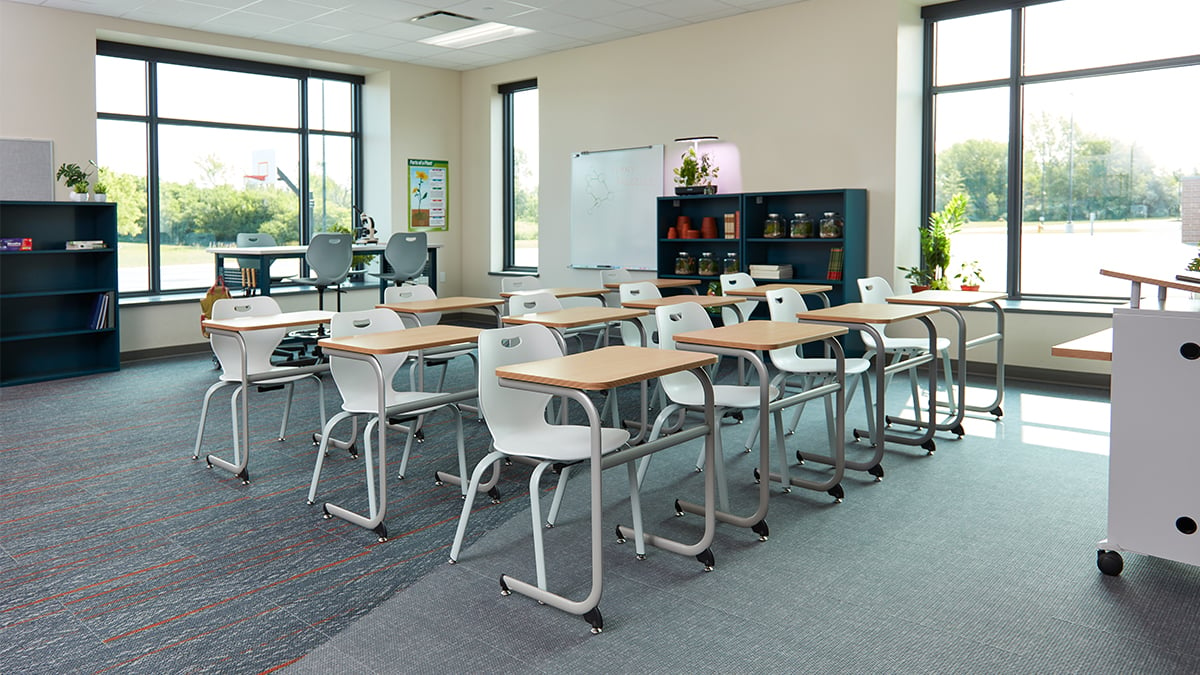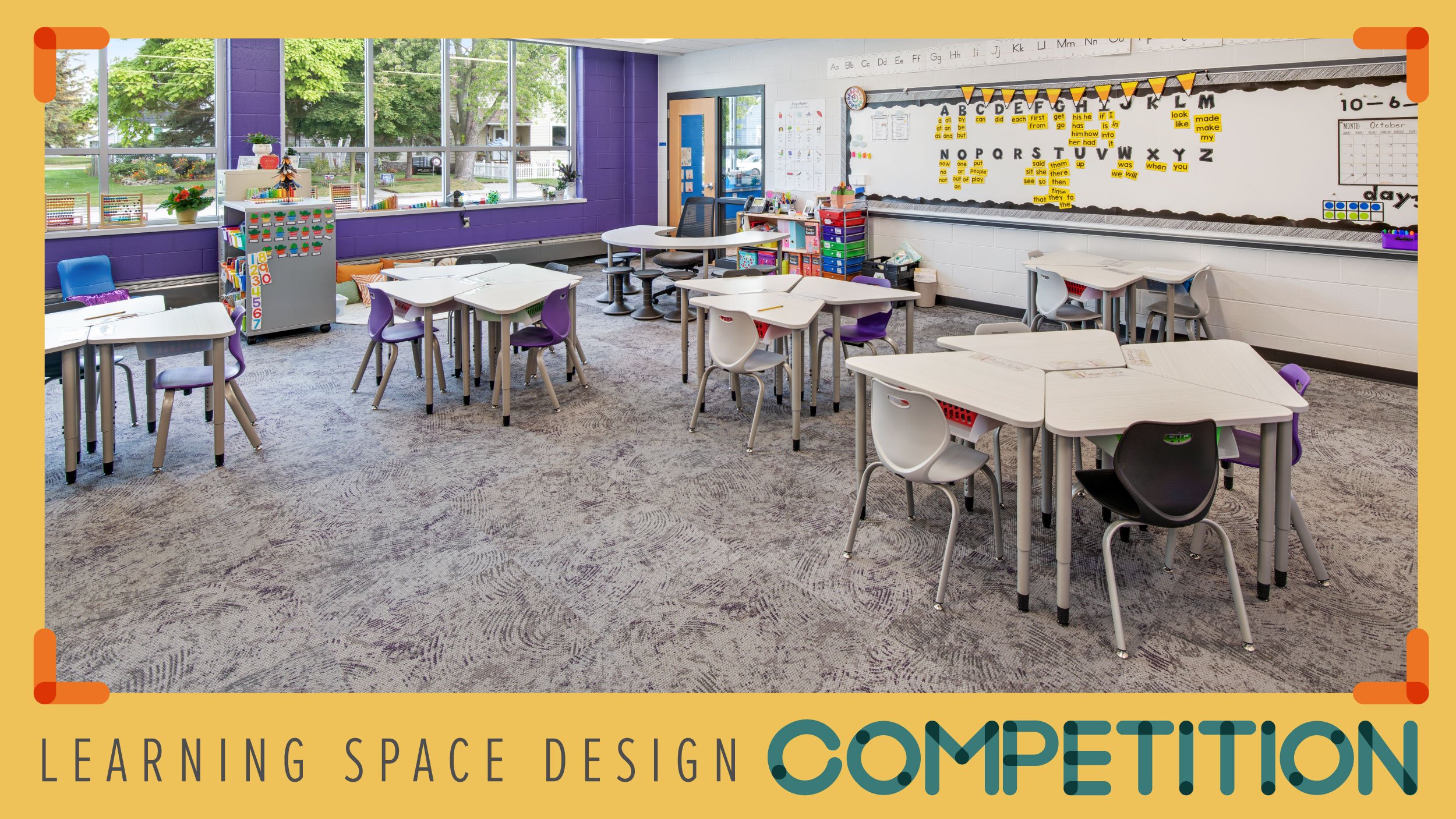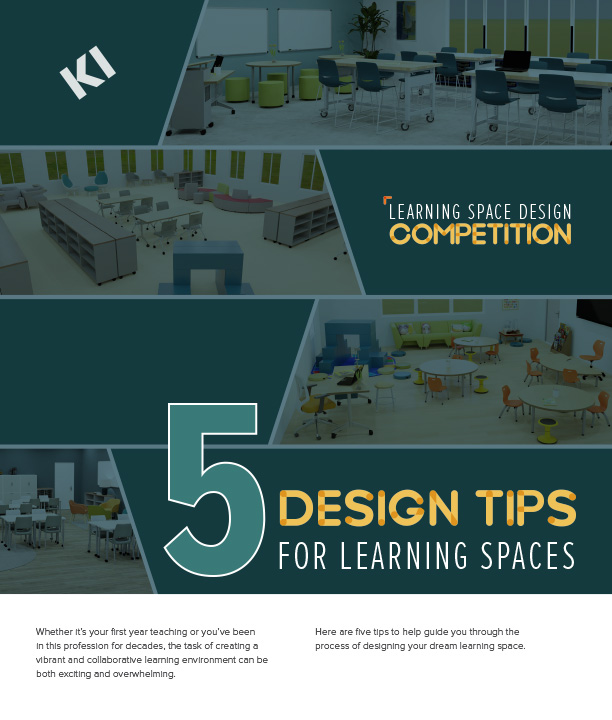5 Design Tips for K-12 Classrooms

Learn five ways to create functional and inspiring classroom environments for your students, including valuable insights from two teachers who won our inaugural classroom furniture giveaway.
A well-designed classroom fosters an ideal learning environment, empowering students to thrive and actively engage in their education.
Whether it’s your first year teaching or you’ve been in this profession for decades, the task of creating a vibrant and collaborative learning environment can be both exciting and overwhelming.
Either way you're feeling, we're here to help! Below we share five tips to help guide you through this process.
1. Prioritize Ergonomics and Comfort
Prioritizing furniture that supports ergonomic principles can help your students stay engaged while they’re learning. If your students don’t have comfortable places to sit and work, it’s much harder for them to pay attention and stay focused.
Marisa Rinkel, who was one of our three classroom giveaway winners last year, selected Ruckus chairs for her fourth-grade classroom at Norco Elementary School in California. She’s already noticed the ergonomic benefits.
“The kids aren’t fighting backaches,” she said. “They’re fidgeting less and focusing more because they can choose to sit any way they want: forwards, backwards, or sideways.”
Also, consider arranging the classroom for your kids to move around safely and easily.
Dylan Zuccarello, another giveaway winner, told us his fifth graders at Lawton Chiles Elementary in Florida have benefitted from larger desks that easily fit their computers and binders. They're also benefiting from a more supportive classroom layout that allows them to easily turn around and talk to their peers.
2. Focus on Flexibility and Adaptability
Classrooms are multifunctional spaces. Throughout the year, week, or even a single day, a classroom may support collaborative work, independent study, reading corners, presentations, large group discussions, and more.
Versatile furniture that can be easily rearranged helps support different activities, learning groups of different sizes, and a variety of teaching styles. A flexible classroom also supports students with a variety of learning and work styles, which gives students the freedom to learn in the way that’s best for them.
Mr. Z reconfigures his classroom layout frequently to arrange his students in pairs, rows, or a giant circle depending on his teaching plan and how he’d like to group students based on their individual needs.
“I’m constantly changing the classroom design depending on my students’ needs,” he said. “It’s easy to provide different approaches to instruction depending on how my room is set up.”
3. Center Accessibility and Inclusivity
No two students are the same. Classrooms should reflect this individuality and provide different options that are accessible and welcoming to all students, including students with different learning, movement, and sensory needs.
That might look like incorporating furniture that allows for moving around or rocking safely. “With the growing rates of students who have ADHD and who have trouble focusing, furniture that supports wiggles can make a huge difference,” Mrs. Rinkel said.
It might also mean creating quiet spaces that minimize auditory or visual stimuli to help students focus or take a breather.
4. Consider Your Students’ Perspectives
Think through how you can involve your students in the classroom design decision-making process for everything from furniture choices and layout to shapes, colors, and finishes.
“Getting student input made such a difference,” Mrs. Rinkel said. “They chose bolder colors than I, as an adult, might have otherwise gravitated toward. We have lime green and orange in the classroom now, and it works! The kids have said things like, ‘The colors make me feel smart.’”
Aside from direct student feedback, you’ll want to consider your students’ preferences, learning needs, ages, and developmental stages as you create a space designed to encourage their growth.
“Put yourself in your students’ shoes,” Mr. Z added. “At the end of the day, this is about them. It isn’t your furniture; it’s for the students.”
Involving students in the classroom design process also fosters a sense of inclusion and ownership. Students will be more engaged and more motivated to keep the space clean and organized for everyone’s benefit.
5. Enhance the Learning Environment
Above all, think about how your classroom can promote student engagement, focus, and creativity.
From natural light to plants, elements inspired by nature can go a long way in creating a calm space that makes students feel comfortable. Research shows that biophilic design elements are correlated with students reporting higher feelings of well-being, mental health, and prolonged concentration.
When designing your learning space, it’s not only about furniture and its arrangement. Consider how lighting, acoustics, aesthetics, and textures play a role, too. Make sure the furniture fits well with permanent elements like room size, flooring, built-in structures, and color scheme.
This combination of factors not only elevates your classroom environment but also cultivates a learning atmosphere that students can truly value.
Bonus Tips:
Before Finalizing Your Classroom Design
Keep in mind that designing your classroom is a journey. It may require a few attempts to get it just right. Use our Classroom Planner tool to explore various ideas and possibilities.
“I probably tried out 10 different designs,” Mrs. Rinkel said of her experience preparing to enter last year’s furniture giveaway. “It’s okay to play around with it until you find the one that you’re most excited about.”
And don’t forget to look for inspiration outside your classroom. Dig into research on design and learning outcomes, connect with other teachers at your school, and peruse Pinterest and other social media for idea starters.
“I actually get a lot of inspiration from other teachers on TikTok,” Mr. Z told us. “When entering last year’s giveaway, I would see certain things in another teacher’s video and then see if KI had something similar in the Classroom Planner that could benefit my teaching space.”
Enter Your Design
Already have an idea ready to go? Enter our learning space design competition from December 1st through 31st for a chance to bring your vision to reality!
Keep these classroom design tips handy by downloading the following PDF that highlights these ideas.
Related Content
 Blog
Blog
Explore insights and perspectives from the teachers who won last year’s classroom contest and learn how you, too, can enter to win the learning space makeover of your dreams.
 Blog
Blog
Design (and redesign) your classroom with these top eight tips to help you optimize the learning environment for your students.
 Blog
Blog
Learn how universal design creates an environment that adapts and responds to students' individual needs in a way that’s impactful for everyone.
Subscribe
Stay up to date with the latest trends and more.

















